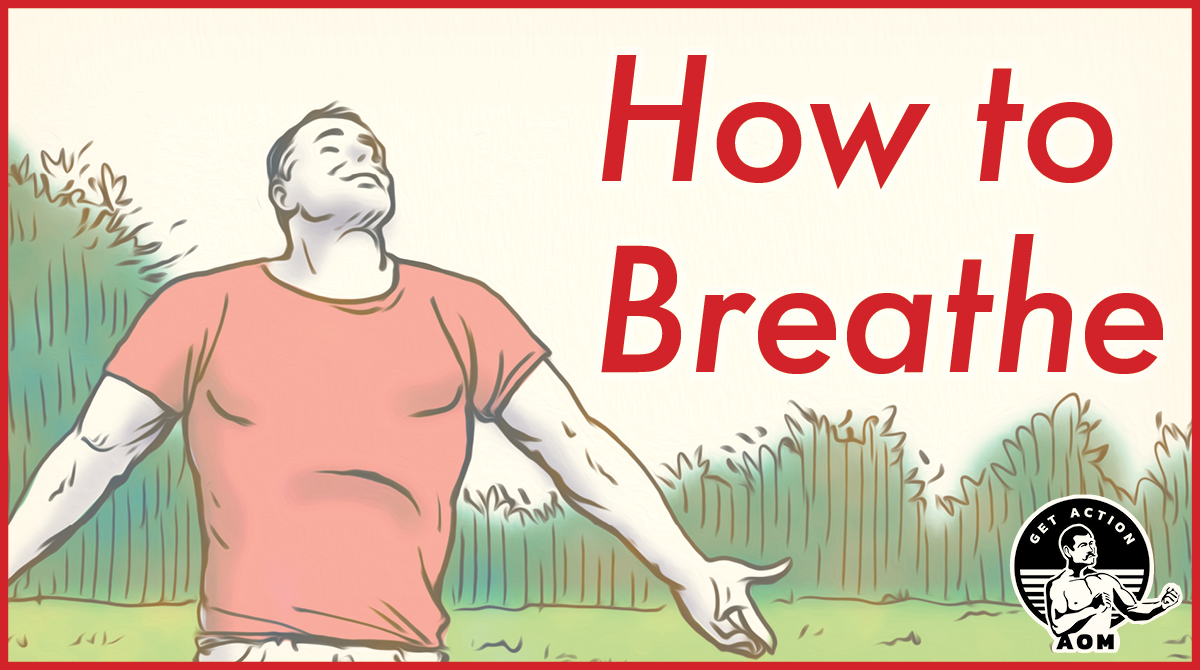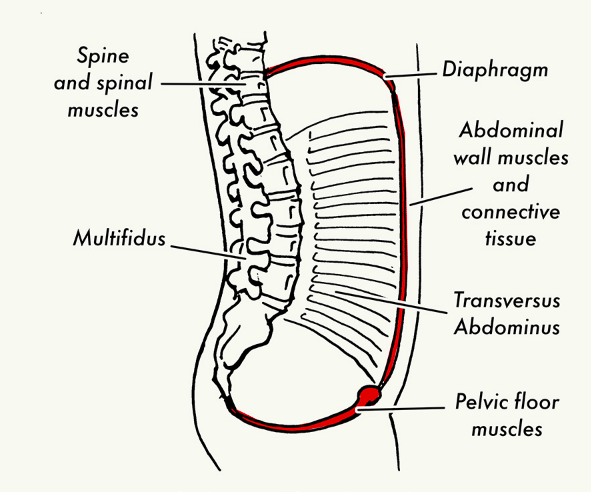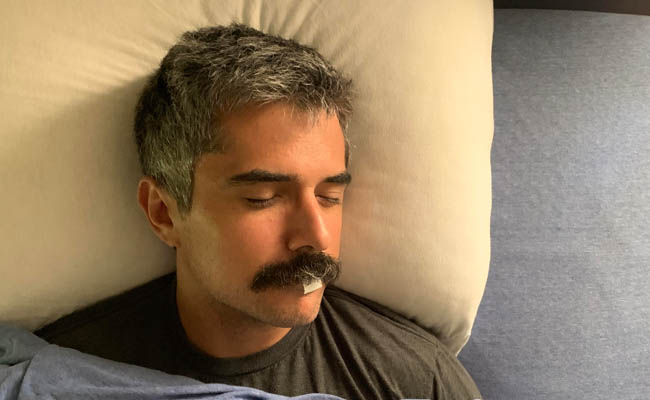
How to breathe? Do people really need instructions on breathing? I mean, isn’t doing so as natural, as, well, breathing?
Well, take a breath right now.
Did your chest go up and down?
Congratulations, you just failed at breathing.
Surprisingly enough, even something as supposedly instinctual as breathing can go awry. But don’t worry, by the time you finish this article, you’ll be on your way back to the kind of optimal breathing you did as a baby, and the better health that comes with it.
What Poor Breathing Looks Like

The majority of people in today’s modern world don’t breathe the way the body is designed to breathe.
Most of us use what breathing expert Dr. Belisa Vranich calls “vertical breathing.” When you breathe vertically, your shoulders go up during the inhale and everything in your torso stretches up vertically. When you exhale, your shoulders go back down.
While it may feel like you’re taking a full breath when you breathe vertically, you’re not. You’re primarily using the tops of your lungs, which are the smallest parts of these organs. By using less of your lungs to inhale, you’re depriving your body of the oxygen it needs to function at its best.
But vertical breathing doesn’t just diminish our inhaling; it also messes up our exhaling. A vertical breath doesn’t allow us to expel all of our air completely. As Dr. Vranich explains, by not fully exhaling, you don’t allow your lungs room to breathe in fresh, new air. You can’t take a full, deep breath because there’s no room in your lungs to do so. This feeling like you can’t really breathe deeply is called air hunger, and it can lead to some health issues like vascular dementia (more on that in a bit).
Vertical breathing isn’t all bad. It’s what your body does naturally when your fight or flight response kicks on. It’s when you’re breathing like that all the time that it becomes a problem.
Why Most Modern People Breathe Poorly
You didn’t start out life doing vertical breathing, and if it’s inefficient and causes potential health problems, why do most modern Westerners fall into this pattern?
In her book Breathe, Dr. Vranich traces the cause to the following factors:
- Stress. Our fast-paced way of life increases stress levels, which increase our propensity to use quick, shallow, vertical breathing. Our constant connectivity and exposure to negativity via messaging apps and social media also increases stress hormones, which can cause us to breathe poorly. Poor breathing induced by stress creates a vicious circle: stress increases the propensity to breathe shallowly and quickly, but breathing shallowly and quickly also increases stress.
- Poor posture. Thanks to habits we’ve picked up from years of sitting all day at school and at work, a lot of us have poor posture. When you’re slumped over, your rib cage collapses a bit, leaving less room for your lungs to open, which in turn causes inefficient breathing.
- Obesity. Extra fat tissue in your stomach and torso can push on your diaphragm and chest wall, leaving less room for your lungs to fill completely with air. Excess weight is also a potential cause for sleep apnea — a serious problem where breathing stops momentarily while you’re asleep.
- Modern clothing. Restrictive clothing like tight pants, compression shorts, and tight belts, also restrict healthy breathing patterns and promote shallow, vertical breathing.
- Air pollution. If you’ve lived in an area with a lot of air pollution, your body’s natural inclination is to NOT take a big deep breath lest you start coughing and hacking. Instead, you’ve likely adapted to the smoggy environment by using a shallow, vertical breathing pattern.
- Smoking. Unless you just arrived in a time machine from 1942, you know smoking damages your lungs. This damage constricts the full use of these respiratory organs, which promotes more “superficial” breathing.
Poor breathing patterns can also be caused simply by being dealt a crummy genetic hand. Chronic allergies, asthma, or a deviated septum can prevent you from breathing properly. In addition to working on your breathing patterns, you’ll need to see a doctor to address these underlying issues.
Other Types of Breathing Issues
Vertical breathing is the most common breathing issue, but other types exist as well.
According to Dr. Vranich, these include:
- Paradoxical breathing. This is when you use the muscles you should be using to exhale to inhale, and use the muscles you should be using to inhale to exhale. The result of this backward breathing is gasping. When you gasp to breathe, your body isn’t getting the oxygen it needs to perform at its best.
- Breath-holding. Some people take a breath and then hold it for several seconds without thinking about it. Those moments of not breathing are depriving your brain of oxygen. It’s not enough to kill you, but it can cause a decrease in mental performance and potential health issues. Some studies suggest that many of us hold our breath momentarily when we check our emails or texts, in anticipation of seeing what’s in a message. Some folks have started calling this phenomenon email apnea.
- Over-breathing. These folks just breathe in and out really fast to the point they hyperventilate, which results in an imbalance of oxygen and carbon dioxide in the system.
- No-halers. No-halers sort of just sip on the air. They breathe in and out just enough to live, but that’s about it.
The Health Risks of Poor Breathing
“Alright,” you might be thinking. “I’m a vertical breather. But big whoop. I’m alive. I run 5Ks. It must not be that big of a deal that I’m not breathing the way nature intended me to.”
While it’s true your poor breathing is giving you enough oxygen to live, you’re likely not getting enough oxygen to function at your very best. What’s more, the health issues that come with poor breathing often come on very slowly, sometimes over years or decades, so it’s hard to recognize that your poor breathing is negatively impacting your vitality.
Dr. Vranich lays out several health issues that can come from improper breathing, and they all stem from a decrease in oxygen. Since your body uses oxygen for a host of physiological processes, when you’ve got less of it, your body and mind don’t function at their best. This can result in:
- Increased stress levels. As mentioned above, stress causes shallow breathing, and shallow breathing causes stress. In small, short doses, stress isn’t bad for us, and in fact, can be beneficial. The problem is that consistent shallow breathing puts us at a consistent level of low-grade stress. And that’s not good for our bodies or our minds. Many of the health issues related to poor breathing likely are linked to shallow breathing-induced stress.
- Reduced focus and concentration. Our brain uses most of the oxygen we breathe to function. If you’re not getting enough oxygen, your brain can’t perform at its most optimal. Studies have shown that when individuals increase oxygen levels, focus and concentration go up.
- Dementia. Studies suggest poor breathing can contribute to dementia. Dr. Vranich’s father had vascular dementia, and she suspects her father’s poor breathing patterns likely contributed to it. (To be clear, we’re not saying poor breathing is the sole or major cause of dementia, but just one factor among many.)
- Low energy. Most of the energy your body produces comes from aerobic metabolism. To create energy, aerobic metabolism requires oxygen. If you have decreased oxygen levels thanks to poor breathing, your body won’t be able to create energy as efficiently as it could.
- Depression and other mood problems. The stress from shallow breathing can contribute to hyper-emotionality. Feelings of depression, anger, or anxiety can increase because of poor breathing.
- Hypertension. A 2007 study suggests constant shallow breathing can contribute to hypertension, also known as high blood pressure.
- Digestive issues. Poor breathing contributes to stress and stress can contribute to digestive issues like indigestion, diarrhea, and nausea.
- Neck pain and headaches. The up and down movement of the shoulders that occurs in vertical breathing may contribute to neck pain and even headaches. Reduced oxygen intake from shallow, vertical breathing may also contribute to headaches. Research from as far back as 1940 has shown a connection between oxygen and headaches. For example, one study showed that when patients suffering from migraine headaches got hooked up to pure oxygen for several minutes, headaches were relieved.
The bottom line here is that while poor breathing might not kill you right away, it can be a contributing factor to myriad health issues and make you feel a low-grade crappiness.
In addition to exercising, eating right, and getting enough sleep, breathing the way nature intended can help optimize your health and well-being.
So let’s dig into how to do it.
How to Breathe Correctly

So an improper breath is vertical. Does that mean a proper breath is horizontal?
Yes, yes it does.
Instead of breathing with your shoulders and chest, a correct breath uses your diaphragm muscles. And when you breathe with your diaphragm muscles, your belly moves in and out, while your chest and shoulders stay still.

The best way to feel and see what proper diaphragmatic breathing feels and looks like is to do this simple exercise:
Grab a stack of light books, lie down on the floor, and place the books on your belly. Now inhale slowly into your belly. If the books are moving up, you’re inhaling correctly. Now exhale, slowly. If the books go back down, you’re exhaling correctly. Do this several times so you can get the feel of it.
Now that you’ve experienced what horizontal breathing feels like while lying down, stand up and take another breath. Your belly should be moving out while your shoulders and chest stay still.
Getting the inhale part of a proper horizontal breath is pretty easy for most folks. The exhale part is a bit trickier.
According to Dr. Vranich, when most people exhale they just relax their stomach and sort of collapse their torso. While that will let some of the air out of your lungs, it doesn’t get all of it out. You need to actively squeeze out the rest.
How do you do that?
By using your pelvic floor.
Your pelvic floor consists of 20 muscles that support the organs near your pelvis. You use your pelvic floor muscles when you stop your pee midstream.
You might be thinking “How are the pelvic floor muscles, which are pretty far away from the lungs, involved with breathing?”
As Dr. Vranich explained in my podcast interview with her, your pelvic floor muscles are connected to your diaphragm via your psoas muscles. The diaphragm and pelvic floor muscles work together to help you inhale as much air as possible, and then exhale as much air as possible.
Let’s try using those pelvic floor muscles for the latter process.
Take a big belly breath in. When you exhale, instead of just relaxing your stomach muscles, squeeze your lower abs and contract your pelvic floor muscles like you’re trying to hold in your pee. Feel how that muscle contraction helps push the air out of your lungs more effectively.

This back and forth between the diaphragm and pelvic floor muscles as you inhale and exhale is sort of how billows work. The diaphragm expands to fill your lungs up with air. Then your pelvic floor contracts to push it out.
In our podcast interview, Dr. Vranich described what happens when you bring the inhale and exhale together to take a proper breath:
On the inhale, I want you to relax your glutes. You relax your pelvic floor. You relax your belly.
[On the] exhale, you squeeze your ribs, your abs, and you contract your pelvic floor.
This is how to breathe properly. This is how nature intended us to breathe before we picked up all those bad habits thanks to modernity.
If you have a baby, watch them sleep. This is how they breathe. Their belly goes out when they inhale, and when they exhale, they actually do it with a bit of force because they’re using their pelvic muscles. Their billows are working as designed.
After years of improper breathing, you’ll have to train yourself to breathe like this again. Spend 5 to 10 minutes each day deliberately practicing your natural and correct breathing. Dr. Vranich recommends doing it right before going to sleep at night, as the slow, deep breathing will help you better relax and drift into slumber.
Throughout the rest of your day, be mindful of your breath (as well as your overall posture). If you notice you’re doing the shallow, vertical breath, shift to a horizontal breath. Eventually, it will become your default again.
Now, will you notice immediate, dramatic effects once you start breathing correctly? Some people Dr. Vranich has worked with did. That could happen to you, too. For me, the benefits of proper breathing came on much more slowly and subtly. My brain feels a bit sharper and I feel a lot more relaxed. Whenever I find myself in a funk, one of the things I focus on is making sure my breath gets back into that natural and effective breathing pattern.
Now you know how to use your lungs at their fullest capacity. Go ahead and breathe a sigh of relief. But don’t forget to contract those pelvic floor muscles when you do.
Be sure to listen to my interview with Dr. Vranich for even more on the science of breathing and additional tips:








